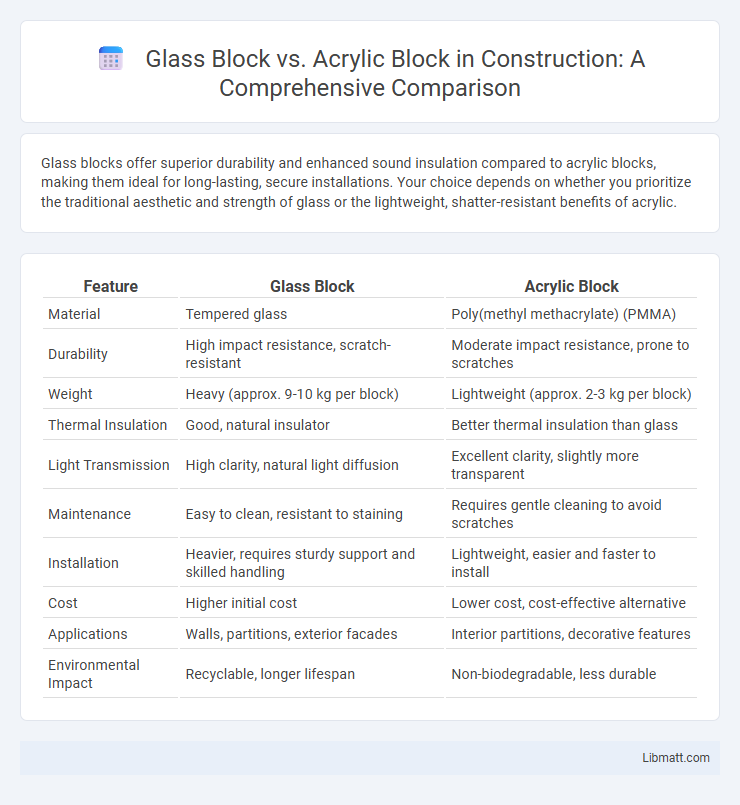Glass blocks offer superior durability and enhanced sound insulation compared to acrylic blocks, making them ideal for long-lasting, secure installations. Your choice depends on whether you prioritize the traditional aesthetic and strength of glass or the lightweight, shatter-resistant benefits of acrylic.
Table of Comparison
| Feature | Glass Block | Acrylic Block |
|---|---|---|
| Material | Tempered glass | Poly(methyl methacrylate) (PMMA) |
| Durability | High impact resistance, scratch-resistant | Moderate impact resistance, prone to scratches |
| Weight | Heavy (approx. 9-10 kg per block) | Lightweight (approx. 2-3 kg per block) |
| Thermal Insulation | Good, natural insulator | Better thermal insulation than glass |
| Light Transmission | High clarity, natural light diffusion | Excellent clarity, slightly more transparent |
| Maintenance | Easy to clean, resistant to staining | Requires gentle cleaning to avoid scratches |
| Installation | Heavier, requires sturdy support and skilled handling | Lightweight, easier and faster to install |
| Cost | Higher initial cost | Lower cost, cost-effective alternative |
| Applications | Walls, partitions, exterior facades | Interior partitions, decorative features |
| Environmental Impact | Recyclable, longer lifespan | Non-biodegradable, less durable |
Introduction to Glass Block and Acrylic Block
Glass blocks offer durability, excellent light transmission, and strong resistance to weather and impact, making them ideal for architectural applications where strength and clarity are critical. Acrylic blocks provide lightweight, shatter-resistant alternatives with greater flexibility and design options, often used in interior partitions and decorative features. Your choice depends on whether you prioritize traditional aesthetics and structural integrity or modern versatility and ease of installation.
Material Composition and Manufacturing Process
Glass blocks are composed primarily of silica sand combined with soda ash and limestone, melted at high temperatures to form a rigid, translucent structure through molding and controlled cooling. Acrylic blocks consist of polymethyl methacrylate (PMMA) resin, produced via polymerization processes that result in a lightweight, impact-resistant synthetic material. The manufacturing of glass blocks involves fusion and annealing to achieve thermal stability, whereas acrylic blocks are cast or extruded and then polished to enhance optical clarity and durability.
Aesthetic Differences and Visual Appeal
Glass blocks offer a classic, polished look with a high-gloss finish that enhances natural light and creates a vibrant, clear visual effect. Acrylic blocks provide a softer, diffused appearance with versatile color options and a lightweight design, making them ideal for modern, creative aesthetics. Your choice depends on whether you prefer the crisp transparency of glass or the customizable, contemporary appeal of acrylic.
Strength, Durability, and Longevity
Glass blocks offer superior strength and durability, with high resistance to scratches and environmental factors, making them ideal for long-term installations. Acrylic blocks, while lighter and more impact-resistant, may scratch more easily and tend to yellow or degrade under prolonged UV exposure, reducing their longevity. For applications requiring maximum structural integrity and extended lifespan, glass blocks are generally the preferred choice.
Light Transmission and Privacy Features
Glass blocks offer superior light transmission with a natural clarity that allows maximum daylight while maintaining excellent privacy through textured surfaces that distort images. Acrylic blocks provide good light diffusion and are lighter and more impact-resistant, but they typically have slightly lower optical clarity compared to glass, balancing light transmission with privacy effectively. Your choice depends on prioritizing higher natural light with traditional elegance (glass) or flexibility and durability with adequate privacy (acrylic).
Thermal Insulation and Energy Efficiency
Glass blocks provide superior thermal insulation due to their thicker, solid structure and inherent thermal mass, which helps regulate indoor temperatures and reduce heating and cooling costs. Acrylic blocks, while lightweight and easier to install, generally offer lower insulation values and may allow more heat transfer, impacting overall energy efficiency. Choosing glass blocks can contribute significantly to energy savings in both residential and commercial buildings by enhancing thermal performance.
Installation Methods and Flexibility
Glass blocks require mortar or specialized adhesive for installation, ensuring a rigid and durable structure, while acrylic blocks use interlocking systems or adhesives that allow for quicker and more flexible assembly. Acrylic blocks offer enhanced flexibility in design due to their lightweight and customizable shapes, making them ideal for temporary or dynamic installations. Glass blocks provide limited adjustment after setting, emphasizing permanence over adaptability in architectural applications.
Maintenance, Cleaning, and Care
Glass blocks require minimal maintenance but can be prone to chipping and cracking, while acrylic blocks are more impact-resistant and lightweight, making them easier to handle. Cleaning glass blocks typically involves mild detergent and water to avoid damaging the surface, whereas acrylic blocks need non-abrasive cleaners and soft cloths to prevent scratching. Your choice between glass and acrylic will impact the frequency and type of care required to keep the blocks looking clear and pristine over time.
Cost Comparison and Budget Considerations
Glass blocks typically cost between $15 to $30 per square foot, offering durable, long-lasting performance but often requiring professional installation that increases total expenses. Acrylic blocks, priced around $10 to $20 per square foot, provide a more budget-friendly option with easier handling and lower installation costs, making them suitable for cost-conscious projects. Budget considerations should also factor in maintenance expenses, as glass blocks resist scratching and discoloration better than acrylic, potentially reducing long-term replacement or repair costs.
Ideal Applications and Use Cases
Glass blocks are ideal for enhancing natural light in bathrooms, kitchens, and exterior walls, providing both privacy and durability with their resistance to moisture and impact. Acrylic blocks offer greater versatility for creative design, lightweight installation, and suitability in areas prone to frequent impact or vibration, such as playrooms or commercial spaces. Your choice between glass and acrylic blocks should consider the balance between aesthetic appeal, structural needs, and maintenance requirements in your specific application.
Glass block vs acrylic block Infographic

 libmatt.com
libmatt.com